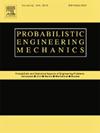Vibration fatigue analysis of structures under non-stationary and non-Gaussian random excitation
IF 3
3区 工程技术
Q2 ENGINEERING, MECHANICAL
引用次数: 0
Abstract
Non-stationary and non-Gaussian random excitation is widely used in the operation of various mechanical systems; therefore, it is necessary to explore the effects of the non-stationary and non-Gaussian excitation signal characteristics on vibration fatigue. A novel method for generating non-stationary and non-Gaussian signals based on amplitude and phase modulation is proposed. The effects of the non-stationary and non-Gaussian random excitation characteristics and their response characteristics on vibration fatigue damage are analyzed in detail by simulation, theoretical derivation, and experiments. The results indicate that as the fatigue exponent b increases, the difference in fatigue damage caused by non-stationary and non-Gaussian signals, stationary and non-Gaussian signals, and stationary and Gaussian signals with the same level becomes more pronounced. Stationary non-Gaussian signals have a significant impact on fatigue damage compared to Gaussian signals when the fatigue exponent b is large. For non-stationary and non-Gaussian signals, kurtosis is more noteworthy than the non-stationary index because changes in the non-stationary index do not have a significant impact on fatigue damage. The fatigue damage of a structure under non-stationary and non-Gaussian random excitation is linearly related to the b-th moment of the absolute value of the structural response, which facilitates an efficient assessment of the fatigue damage.
求助全文
约1分钟内获得全文
求助全文
来源期刊

Probabilistic Engineering Mechanics
工程技术-工程:机械
CiteScore
3.80
自引率
15.40%
发文量
98
审稿时长
13.5 months
期刊介绍:
This journal provides a forum for scholarly work dealing primarily with probabilistic and statistical approaches to contemporary solid/structural and fluid mechanics problems encountered in diverse technical disciplines such as aerospace, civil, marine, mechanical, and nuclear engineering. The journal aims to maintain a healthy balance between general solution techniques and problem-specific results, encouraging a fruitful exchange of ideas among disparate engineering specialities.
 求助内容:
求助内容: 应助结果提醒方式:
应助结果提醒方式:


